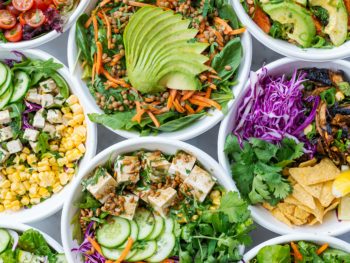Below is my blog post for Huffington Post, Federal serving sizes differ from typical portion: 10 tips to avoid portion distortion.
You can also read it HERE.
As a portion-size researcher, I have been tracking trends in growing food portions and how they compare to federal standards. As I have written in my book The Portion Teller Plan and demonstrated in my research papers, food portions have increased considerably over the past 50 years, continue to increase despite public health messages urging us to eat less, and greatly exceed federal standards. In addition to the implications for obesity that larger portions have (big portions contain more calories than small portions and can lead to weight gain), educating consumers on how to relate typical portions to federal standards has become increasingly more difficult.
Now, new research commissioned by the British Heart Foundation (BHF) of the U.K. has found that typical portions have changed over the past 20 years and the European guidance on portion sizes is out of date. The U.K. government has recommended that the food industry display per portion values on the front of a package label for calories, fat, sugar and salt. However, according to the new research, the information on the food labels are no longer based on realistic serving sizes.
The researchers write,
The portion size of several products — including single serve packets of crisps, portions of corn flakes and cheddar cheese — are all identical to the information provided twenty years ago…
However, this pattern is not reflected across the products analyzed as a whole, with some showing considerable growth since 1993. In particular, certain bread products and all of the ready meals analyzed showed substantial growth in portion size — as much as 98 percent for one ready meal.
The researchers also note that consumers are confused about portion sizes. Consumers tend to eat bigger portions and overestimate how much they should actually be eating.
As Simon Gillespie, chief executive of the BHF writes “Our research shows there is no meaningful understanding of what is an appropriate portion size. The size of some portions has doubled, while others are so varied between different suppliers and manufacturers that trying to make comparisons is nigh on impossible.”
Like the U.K. researchers found, my research found that U.S. portion sizes differ drastically from federal standards.
For example, while the serving size of pasta on a food label is one cup, most people eat a lot more than that. Indeed, a restaurant portion of pasta is around three cups. And, when making a peanut butter sandwich, how many people actually scoop out the two-tablespoon serving size that the food label suggests?
However, it is a complicated issue.
As I discussed in a thoughtful Q&A with Food Navigator about the portion problem with food labels of packaged foods in the U.S.:
“While unrealistically small serving sizes can make unhealthy products appear in a more favorable light, simply making serving sizes bigger to reflect what people eat is not without it’s own risks.”
As I further explained, “Current serving sizes used for food labels were based on what people reported eating decades ago and we all know that what people say they eat and what they actually eat are two different things, so it makes sense to look at them again. However, if you make the serving sizes too large to reflect what many people are likely to eat, the risk is that people will think the government is telling me I can eat more.”
As summarized in a paper I co-authored with my NYU colleague Marion Nestle, in the American Journal of Preventive Medicine “federal standards bear little relationship to typical marketplace portions.”
And complicating the problem in the U.S., the FDA sets standards for food labels and the USDA sets standards for dietary guidance and education. These standards are smaller than typical portions, differ from one another, and may be creating more confusion. As we suggest, “One uniform system is needed to better advise the public on the relationship between portion size, calories and weight gain.”
So, until the federal government (both in the U.S. and the U.K.) addresses the portion distortion issue, what is the take home message for consumers? I advise clients that I counsel that referring to the serving size information on package labels can be educational but should be looked at with a critical eye.
Here are some tips.
1. Do not assume that the serving size information listed is what you will actually eat.
Reading serving size information can be very educational, if you pay close attention to the actual size (weight or volume) listed on the label. The label will tell you, for example, that if you eat a three quarters of a cup of cereal, it will contain 100 calories. However, if you eat double that amount, you will need to recognize that you are actually eating double the calories as well. Sounds like common sense, but for many of us, it does not register that bigger portions contain more calories.
2. Pay close attention to the number of servings per container or per package.
Even if you eat an entire muffin or candy bar that appears to be marketed for one person, the information on the serving size often states that it contains multiple servings.
3. Use visuals to help you estimate your serving size.
One cup of pasta is the size of a baseball. Two tablespoons peanut butter is the size of a walnut in a shell. Three ounces of meat is the size of a deck of cards. Becoming familiar with visuals can help you eyeball standard serving sizes so that you can then compare these servings to how much you actually eat. Because most of us can visualize common objects it’s a great way to keep portions in check. It makes you think about how much food you’re piling on your plate.
Here is my visual guide to eyeballing serving sizes.
• Nuts, quarter cup = golf ball
• Salad dressing or olive oil, two tablespoons = shot glass
• Peanut butter, two tablespoons = walnut in a shell
• Ice cream, half cup =half baseball
• Cheese, two ounces = eight dice
• Pasta or rice, one cup = baseball
• Oil, one teaspoon = water-bottle cap
• Meat, fish, or poultry, three ounces = deck of cards
• Bread, one ounce slice = CD case
4. Don’t snack out of a jumbo bag.
Familiarize yourself with the serving size on the food label, pour yourself one serving, and put the bag away. Practice this for chips, nuts, pretzels and other treats
5. Don’t be fooled by health halos and health claims on package labels.
Just because a food is labeled organic, gluten free, or low-fat doesn’t mean you can eat as much as you want. Calories are calories!
6. Fill up on fresh fruits and veggies.
You can’t go wrong by adding more fresh fruits and veggies that do not bear package labels to your plate. Eat an apple as a snack, add fresh berries to your yogurt, and fill half of your dinner plate with fresh vegetables. Fruits and vegetables are relatively low in calories and rich in nutrients so you can eat more without worrying too much about gaining weight.
7. Avoid your trigger foods.
If you can’t stop at one serving of chips or pretzels, then don’t even buy it. Choose a treat you can control and portion out.
8. Pay attention to how hungry you actually are and what else you are eating throughout the day.
9. Remember, you don’t need to eat the whole thing.
10. And finally, less is more!
As I often highlight in my talks, “What kind of sandwich isn’t fattening?” My answer: “half a sandwich.”



